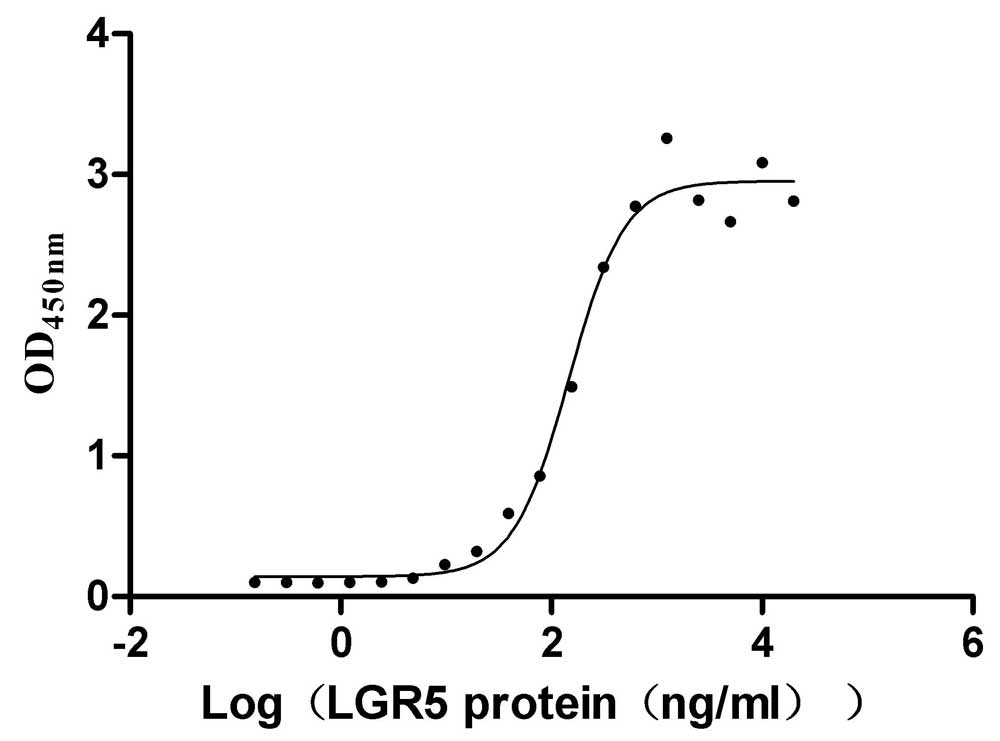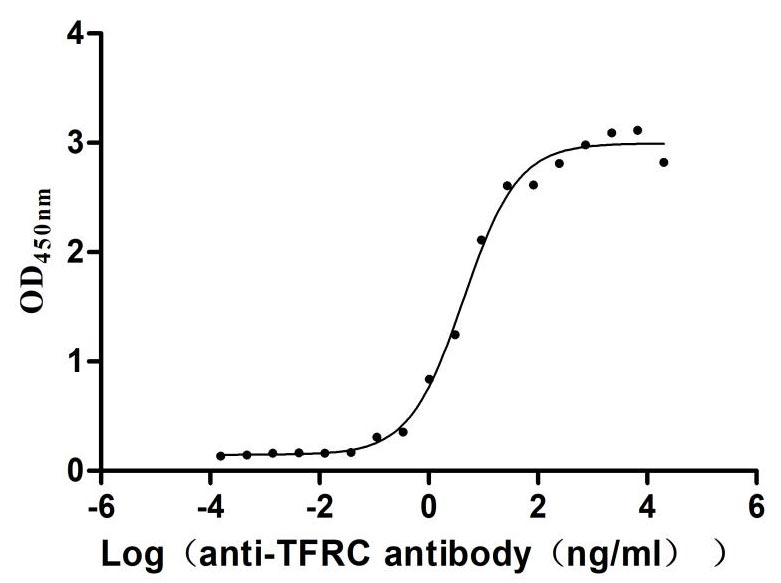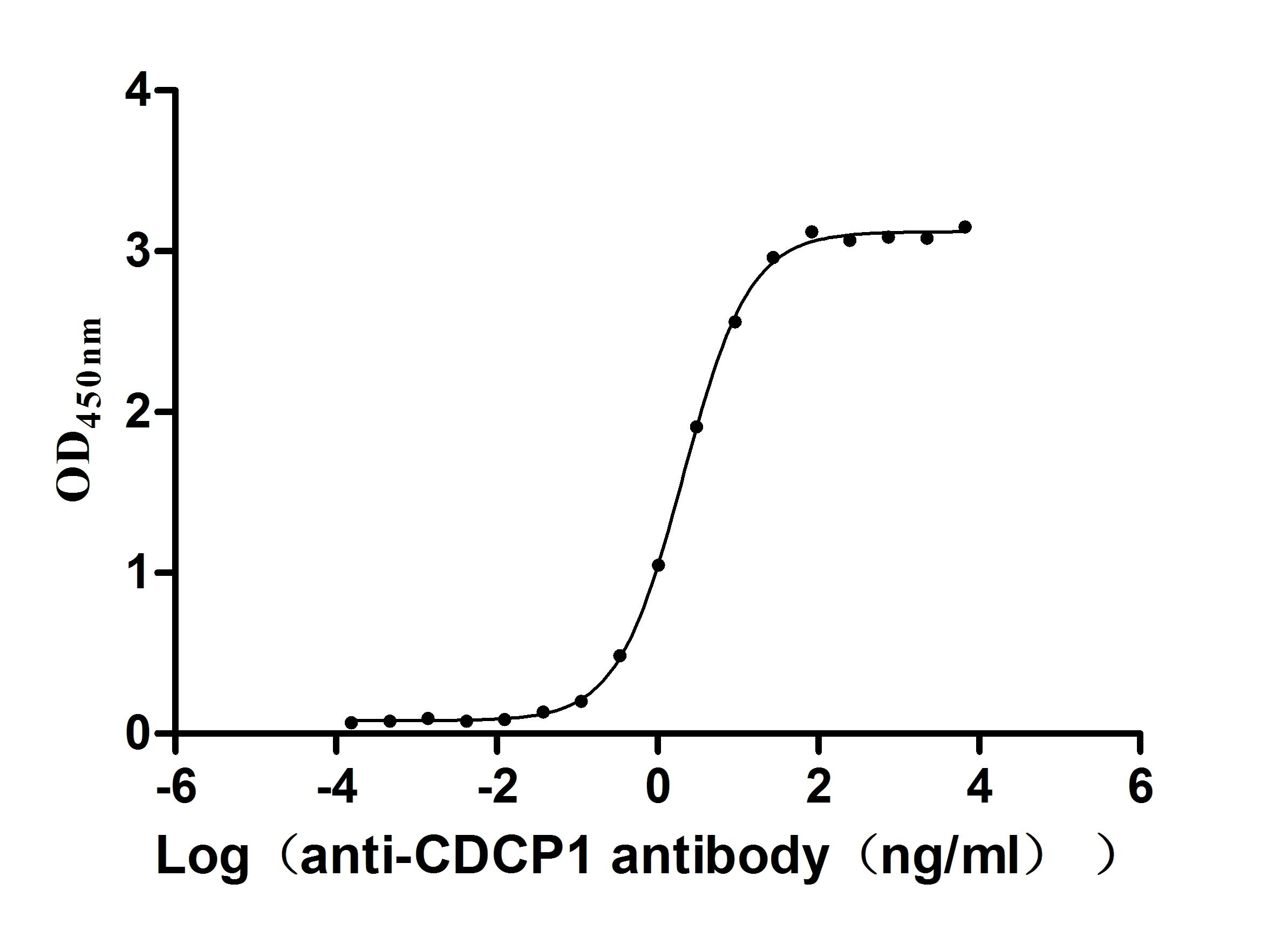Recombinant Mouse Signal transducer and activator of transcription 5A (Stat5a)
-
货号:CSB-YP022814MO
-
规格:
-
来源:Yeast
-
其他:
-
货号:CSB-EP022814MO
-
规格:
-
来源:E.coli
-
其他:
-
货号:CSB-EP022814MO-B
-
规格:
-
来源:E.coli
-
共轭:Avi-tag Biotinylated
E. coli biotin ligase (BirA) is highly specific in covalently attaching biotin to the 15 amino acid AviTag peptide. This recombinant protein was biotinylated in vivo by AviTag-BirA technology, which method is BriA catalyzes amide linkage between the biotin and the specific lysine of the AviTag.
-
其他:
-
货号:CSB-BP022814MO
-
规格:
-
来源:Baculovirus
-
其他:
-
货号:CSB-MP022814MO
-
规格:
-
来源:Mammalian cell
-
其他:
产品详情
-
纯度:>85% (SDS-PAGE)
-
基因名:
-
Uniprot No.:
-
别名:Stat5a; Mgf; Mpf; Signal transducer and activator of transcription 5A; Mammary gland factor
-
种属:Mus musculus (Mouse)
-
蛋白长度:Full length protein
-
表达区域:1-793
-
氨基酸序列MAGWIQAQQL QGDALRQMQV LYGQHFPIEV RHYLAQWIES QPWDAIDLDN PQDRGQATQL LEGLVQELQK KAEHQVGEDG FLLKIKLGHY ATQLQNTYDR CPMELVRCIR HILYNEQRLV REANNCSSPA GVLVDAMSQK HLQINQRFEE LRLITQDTEN ELKKLQQTQE YFIIQYQESL RIQAQFAQLG QLNPQERMSR ETALQQKQVS LETWLQREAQ TLQQYRVELA EKHQKTLQLL RKQQTIILDD ELIQWKRRQQ LAGNGGPPEG SLDVLQSWCE KLAEIIWQNR QQIRRAEHLC QQLPIPGPVE EMLAEVNATI TDIISALVTS TFIIEKQPPQ VLKTQTKFAA TVRLLVGGKL NVHMNPPQVK ATIISEQQAK SLLKNENTRN ECSGEILNNC CVMEYHQATG TLSAHFRNMS LKRIKRADRR GAESVTEEKF TVLFESQFSV GSNELVFQVK TLSLPVVVIV HGSQDHNATA TVLWDNAFAE PGRVPFAVPD KVLWPQLCEA LNMKFKAEVQ SNRGLTKENL VFLAQKLFNI SSNHLEDYNS MSVSWSQFNR ENLPGWNYTF WQWFDGVMEV LKKHHKPHWN DGAILGFVNK QQAHDLLINK PDGTFLLRFS DSEIGGITIA WKFDSPDRNL WNLKPFTTRD FSIRSLADRL GDLNYLIYVF PDRPKDEVFA KYYTPVLAKA VDGYVKPQIK QVVPEFVNAS TDAGASATYM DQAPSPVVCP QPHYNMYPPN PDPVLDQDGE FDLDESMDVA RHVEELLRRP MDSLDARLSP PAGLFTSARS SLS
-
蛋白标签:Tag type will be determined during the manufacturing process.
The tag type will be determined during production process. If you have specified tag type, please tell us and we will develop the specified tag preferentially. -
产品提供形式:Lyophilized powder
Note: We will preferentially ship the format that we have in stock, however, if you have any special requirement for the format, please remark your requirement when placing the order, we will prepare according to your demand. -
复溶:We recommend that this vial be briefly centrifuged prior to opening to bring the contents to the bottom. Please reconstitute protein in deionized sterile water to a concentration of 0.1-1.0 mg/mL.We recommend to add 5-50% of glycerol (final concentration) and aliquot for long-term storage at -20℃/-80℃. Our default final concentration of glycerol is 50%. Customers could use it as reference.
-
储存条件:Store at -20°C/-80°C upon receipt, aliquoting is necessary for mutiple use. Avoid repeated freeze-thaw cycles.
-
保质期:The shelf life is related to many factors, storage state, buffer ingredients, storage temperature and the stability of the protein itself.
Generally, the shelf life of liquid form is 6 months at -20°C/-80°C. The shelf life of lyophilized form is 12 months at -20°C/-80°C. -
货期:Delivery time may differ from different purchasing way or location, please kindly consult your local distributors for specific delivery time.Note: All of our proteins are default shipped with normal blue ice packs, if you request to ship with dry ice, please communicate with us in advance and extra fees will be charged.
-
注意事项:Repeated freezing and thawing is not recommended. Store working aliquots at 4°C for up to one week.
-
Datasheet :Please contact us to get it.
靶点详情
-
功能:Carries out a dual signal transduction and activation of transcription. Mediates cellular responses to the cytokine KITLG/SCF and other growth factors. May mediate cellular responses to activated FGFR1, FGFR2, FGFR3 and FGFR4. Binds to the GAS element and activates PRL-induced transcription. Regulates the expression of milk proteins during lactation.
-
基因功能参考文献:
- HSP27 is a partner of JAK2-STAT5 and a potential therapeutic target in myelofibrosis. PMID: 29650953
- NK cell numbers are decreased in Stat5a-Stat5b tetramer-deficient double knockin mice, but the mechanism was not investigated. Here we show that STAT5 dimers are sufficient for NK cell development, whereas STAT5 tetramers mediate NK cell maturation and the expression of maturation-associated genes. PMID: 29105654
- endogenous growth hormone induces UCP1 expression in adipose tissue via STAT5 PMID: 29111497
- Each mutation decreased STAT5 binding and altered IL-2-induced Il2ra gene expression, revealing that individual elements within the superenhancer were not functionally redundant and that all were required for normal gene expression. PMID: 29078395
- findings indicate that STAT5 contributes to the remarkable IL-3-mediated inhibition of RANKL-induced osteoclastogenesis by activating Id genes and their associated pathways. PMID: 27485735
- Results suggest activation of H2AX via promoter demethylation in specific populations of basal mammary cells that is induced by a signal from neighboring luminal cells with hyper STAT5 activity. PMID: 27260000
- On the basis of our ChIP data and these previous findings, we hypothesize that PDC may modulate STAT5's ability to regulate gene expression by controlling histone or STAT5 acetylation PMID: 28982698
- STAT5 gene deletion had a minor effect on cholesterol metabolism, as evidenced by no changes in expression of cholesterol transport and cholesterol synthesis genes, and numeric changes in serum and liver cholesterol levels. These minor changes in cholesterol metabolism may not have been sufficient to influence on cholesterol crystal and gallstone formation in lithogenic diet-fed STAT5 LKO mice. PMID: 27816761
- Stat5 deficiency has a strong impact upon transcriptional heterogeneity in single sorted c-Kit+Lin-Sca-1+ (KLS) cells or CD150+CD48- KLS long-term repopulating hematopoietic stem cells. PMID: 28390194
- mice carrying Stat5a/b inactivation specifically in kisspeptin cells were generated. These mutants exhibited an early onset of estrous cyclicity, indicating that STAT5 transcription factors exert an inhibitory effect on the timing of puberty. PMID: 28344041
- Upon deletion of the STAT5 response elements from the Socs2 promoter in mice, cytokine induction was abrogated, while basal activity remained intact. Our data suggest that promoter-bound STAT5 modulates cytokine responses and enhancer-bound STAT5 is mandatory for gene activation. PMID: 28009300
- Instead, we find that STAT5B is dominant over STAT5A in CD4(+) 'helper' T cells for both effector and regulatory (Treg) responses and, therefore, uniquely necessary for immunological tolerance. PMID: 26999798
- Data indicate that obesity-induced insulin resistance and lipotoxicity can be treated with ginsenoside Rg3, which acts though the STAT5-PPAR gamma pathway in vivo and in vitro. PMID: 29042402
- STAT5 signaling axis drives abnormal cell proliferation in autosomal dominant polycystic kidney disease. PMID: 28104302
- STAT5a regulates miR-135a transcription by binding to both miR-135a-1 and miR135a-2 promoter elements PMID: 27276245
- These studies establish the importance of STAT5 in macrophages during ductal morphogenesis in the mammary gland and demonstrate that altering STAT5 function in macrophages can affect the development of tissue-specific disease. PMID: 28606561
- findings show that Stat5 is required for CD103(+) dendritic cell and alveolar macrophage development.These findings demonstrate the critical importance of Stat5 signaling in maintaining lung homeostasis, and underscore the importance of resident macrophages in moderating tissue damage and excess inflammation. PMID: 28500076
- STAT5 target genes such as Oncostatin M were highly expressed in FLT3-ITD(+) myeloid but not in FLT3-ITD(+) lymphoid progenitor cells; lineage-specific STAT5 activation in hematopoietic progenitor cells predicts the FLT3(+)-mediated leukemic phenotype in mice. PMID: 27046463
- findings reveal an essential role for STAT5 in maintaining lipid homeostasis in white adipose tissue and provide a rationale for future studies into the potential of STAT5 manipulation to improve outcomes in metabolic diseases. PMID: 27858140
- deregulation of local signal transducer and activator of transcription 5 signaling augments high fat diet-induced lipid accumulation in both muscle and liver. PMID: 26582580
- Data show that CUZD1 interacts with a complex containing JAK1/JAK2 and STAT5, downstream transducers of prolactin signaling in the mammary gland. PMID: 28278176
- The study describes an interaction network of STAT5a/LSD1/HDAC3 and a dual function of LSD1/HDAC3 on STAT5a-dependent transcription, defined by protein-protein interactions, genomic binding localization/affinity and motifs. PMID: 27651463
- this study shows that lipoxin A4 protects against LPS-induced sepsis by promoting the generation and migration of splenic innate response activator B cells, and the underlying molecular mechanism may be related to STAT5 activation PMID: 27494686
- Mechanistically, RL negatively regulates Stat5 phosphorylation and Elf5 expression at the onset of lactogenesis. Continuous RL exposure leads to the expansion of basal and bipotent cells in WT and MMTV-RANK acini. Overall, we demonstrate that enhanced Rank signaling impairs secretory differentiation during pregnancy by inhibition of the prolactin/p-Stat5 pathway. PMID: 26695351
- Bcl6 promoted T follicular helper cell differentiation through antagonizing IL-7R / STAT5a axis. PMID: 26876184
- constitutive STAT5 binding to c-Myc super-enhancer might contribute to BRD2 maintenance and thus allow sustained expression of c-Myc in Ba/F3 cells transformed by STAT5-1*6. PMID: 27074708
- transduction of developing Th9 cells with a constitutively active STAT5 eliminates the ability of IL-6 to reduce IL-9 production. PMID: 26976954
- Strong selective advantage for leukemic transformation in the background of Stat5 deficient hematopoiesis was permissive for faster initiation of Myc-induced transformation to B-ALL. PMID: 26338970
- Thrombopoietin-mediated phosphorylation of STAT5 triggers its genome-wide relocation to STAT consensus sites, resulting in loss of a uSTAT5 program that restrains megakaryocytic differentiation and activation of STAT5-driven gene expression. PMID: 26702099
- Transcriptome analysis identified a class of mammary-restricted genes that was particularly dependent on high STAT5 levels as a result of the intergenic enhancer PMID: 26446995
- domain-mapping results showed that both the substrate-interacting and the phosphatase domains of DUSP4 were required for its optimal interaction with STAT5, while the coiled-coil domain of STAT5 appeared to hinder this interaction PMID: 26710253
- STAT5 activation by FLT3-ITD protects cells treated with the PI3K/Akt pathway inhibitors from apoptosis by maintaining Mcl-1 expression through the mTORC1/4EBP1/eIF4E pathway. PMID: 25826077
- Collectively, the findings show that human beta-cells fail to proliferate in response to PRL for multiple reasons, one of which is a paucity of functional PRL receptors, and that murine Stat5 overexpression is able to bypass these impediments. PMID: 26159175
- STAT5 signaling is increased in the liver in GH-transgenic mice during the growth period, with a balance between positive and negative effectors resulting in accelerated but controlled growth. PMID: 25691498
- These data provide the first definitive evidence for a contribution of STAT5a/b to the sex bias in pulmonary hypertension in the hypoxic mouse and implicate reduced STAT5 in the pathogenesis of the human disease. PMID: 25470773
- direct binding of STAT5 to STAT motifs in the Jgamma promoter is essential for local chromatin accessibility and Jgamma/Egamma chromatin interaction, triggering rearrangements of the TCRgamma locus. PMID: 26195811
- the dynamic interaction between mTOR and STAT5 signaling modulates the reciprocal differentiation of the effective and regulatory T cells, and differently affect their proliferation activity. PMID: 25468562
- Activated STAT5 confers resistance to intestinal injury by increasing intestinal stem cell proliferation and regeneration PMID: 25579133
- Data show that three hypotheses of dimer formation between STAT5 transcription factors STAT5A and STAT5B were used to explain the analytical results by a static mathematical model. PMID: 25333863
- constitutively active STAT5A(S710F) escapes from SFK-mediated cytoplasmic retention by enhancing STAT5A dimer stability PMID: 25885255
- Our data identify Stat5 as a dose-dependent regulator of CD8(+) T-cell functions in contact allergies and suggest that modulation of Stat5 dosage could be used to target contact allergies in humans. PMID: 25333229
- Loss of encephalitogenic activity of STAT5-deficient autoreactive CD4+ T cells was independent of IFN-gamma or IL-17 production, but was due to the impaired expression of GM-CSF, a crucial mediator of T-cell pathogenicity. PMID: 25412660
- These results reveal a leukemic pathway involving FAK/Tiam1/Rac1/PAK1 and demonstrate an essential role for these signaling molecules in regulating the nuclear translocation of Stat5 in leukemogenesis. PMID: 25456130
- Our study reveals that the STAT5-GATA2 pathway is critical for basophil and mast cell differentiation and maintenance. PMID: 25801432
- STAT5 is recruited to the IL-25R in a ligand-dependent manner through unique tyrosine residues on IL-17RB. Together, these findings reveal a novel Act1-independent IL-25 signaling pathway through STAT5 activation. PMID: 25821217
- data imply a role for Hspa9 in B lymphopoiesis and Stat5 activation downstream of IL-7 signaling PMID: 25550197
- ICOS-ICOS-L interaction promoted cytokine production and survival in type 2 innate lymphoid cells through STAT5 signaling in asthma. PMID: 25769613
- TMPRSS6 inhibition via decreased STAT5 phosphorylation may be an additional mechanism by which inflammation stimulates hepcidin expression to regulate iron homeostasis and immunity. PMID: 24376517
- STAT5 regulates the miR-193b locus during the functional development of mammary tissue during pregnancy. PMID: 25236432
- Miz1 deficiency provokes attenuation of stat5 expression and phosphorylation. PMID: 24586582
显示更多
收起更多
-
亚细胞定位:Cytoplasm. Nucleus. Note=Translocated into the nucleus in response to phosphorylation.
-
蛋白家族:Transcription factor STAT family
-
组织特异性:In the virgin, found in most tissues except brain and muscle. During lactation, abundantly found in mammary tissue, as well as in other secretory organs such as salivary gland and seminal vesicle.
-
数据库链接:
KEGG: mmu:20850
STRING: 10090.ENSMUSP00000102980
UniGene: Mm.277403
Most popular with customers
-
Recombinant Human R-spondin-1 (RSPO1), partial (Active)
Express system: Mammalian cell
Species: Homo sapiens (Human)
-
Recombinant Human C5a anaphylatoxin chemotactic receptor 1 (C5AR1)-VLPs (Active)
Express system: Mammalian cell
Species: Homo sapiens (Human)
-
Recombinant Human Microtubule-associated protein tau (MAPT) (Active)
Express system: Mammalian cell
Species: Homo sapiens (Human)
-
Recombinant Human Claudin-6 (CLDN6)-VLPs, Fluorescent (Active)
Express system: Mammalian cell
Species: Homo sapiens (Human)
-
Recombinant Human Transferrin receptor protein 1 (TFRC), partial (Active)
Express system: Mammalian cell
Species: Homo sapiens (Human)
-
Recombinant Mouse Gastric inhibitory polypeptide receptor (Gipr), partial (Active)
Express system: Mammalian cell
Species: Mus musculus (Mouse)
-
Recombinant Macaca fascicularis CUB domain containing protein 1 (CDCP1), partial (Active)
Express system: Mammalian cell
Species: Macaca fascicularis (Crab-eating macaque) (Cynomolgus monkey)
-
Recombinant Human C-C chemokine receptor type 6(CCR6)-VLPs (Active)
Express system: Mammalian cell
Species: Homo sapiens (Human)




-AC1.jpg)
f4-AC1.jpg)














